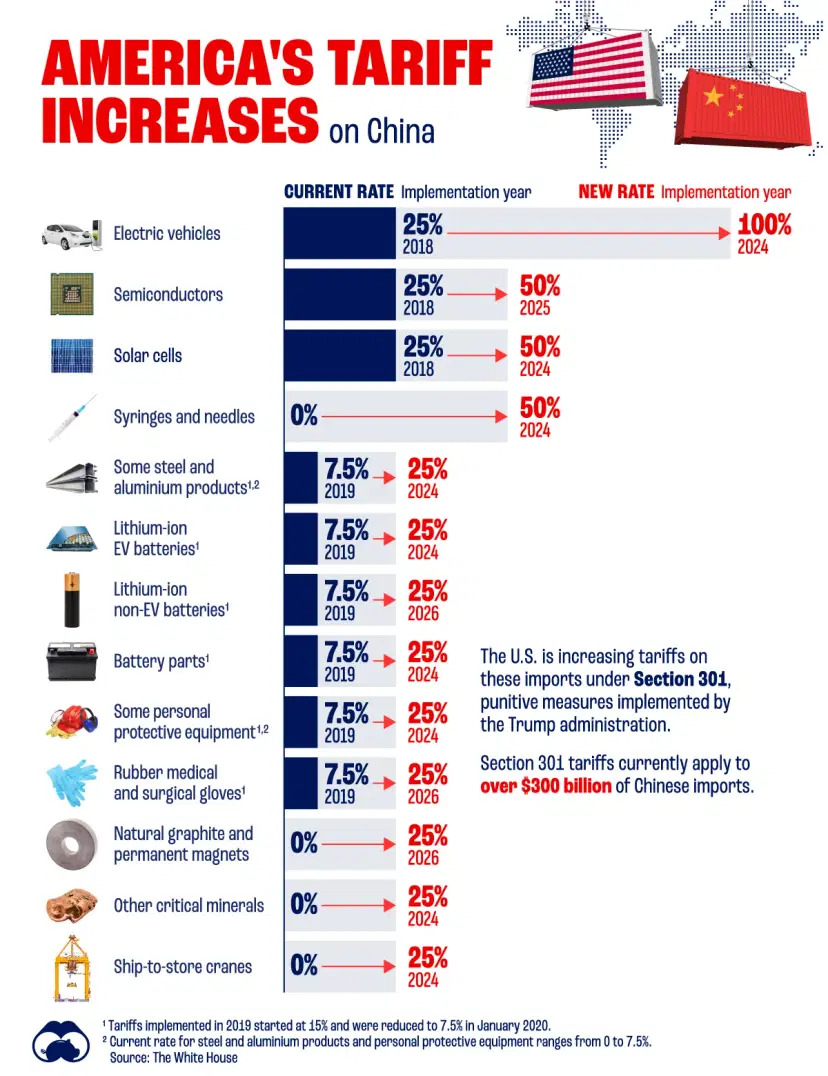
The United States does not have a coherent trade policy. It has a political strategy masquerading as trade policy that has taken dead aim at China. Unsurprisingly, China has responded in kind. With the two superpowers drawing on their allies for support – the US leaning on the G7 and China turning to the Global South – economic decoupling is the least of our problems.
It is easy to blame US Presidents Donald Trump and Joe Biden for this unfortunate turn of events – Trump for firing the first shot in the Sino-American trade war, and Biden for doubling down on protectionism. Yet the problems predate both presidents – they stem largely from a decades-long misunderstanding of the role foreign trade plays in open economies.
Politicians tend to see trade balances in black and white: surpluses are good, deficits are bad. For the US, where the merchandise trade balance has been in deficit for all but two years since 1970, trade is viewed as bad – a source of leakage in an otherwise strong economy that puts pressure on jobs, companies, communities, and incomes.
From this perspective, America sees itself as the hapless victim of others’ transgressions. Japan was the culprit in the 1980s. Now it’s China. The US also blames the World Trade Organization, which it has effectively neutered by blocking appointments to the WTO Appellate Body for the past five years.
Blame is about politics, not economics. Students of economics are taught almost immediately to respect a basic premise of national income accounting: that a country’s trade balance is equal to the difference between investment and saving. It follows that any savings-short economy wanting to invest and grow must borrow surplus savings from abroad, which requires balance-of-payments and trade deficits with the rest of the world.
This conceptual framework fits the US economy to a tee. In 2023, America’s net domestic savings rate – the combined depreciation-adjusted savings of individuals, businesses, and the government sector – was negative, at -0.3% of national income, compared to a post-World War II average of 6.4%. This has happened only once before: during and immediately after the global financial crisis of 2008-09.
This leads to a politically uncomfortable verdict on trade: in keeping with national income identities, savings-short America runs massive external deficits. In 2023, the current-account deficit was equivalent to 3% of GDP, and the merchandise trade deficit was 3.9% of GDP – more than double the postwar averages of 1.3% and 1.7%, respectively.

(Photo: Visual Capitalist)
Blaming others for this problem is a cop-out. Without a shortfall of domestic savings, there would be no trade deficit. And that shortfall is largely made at home – the result of outsize federal budget deficits that are counted as negative savings in the national income accounts. After ballooning during the COVID-19 recession to 13.3% of GDP in 2020-21, the budget deficit remained stuck at 5.8% of GDP in 2022-23, nearly double the 3.2% average from 1962 to 2019. Moreover, the Congressional Budget Office’s baseline projections suggest that the deficit share will remain around its current level for the next decade.
This outcome is not China’s fault. It is a result of conscious decisions by US politicians. Yet Trump pinned the blame for America’s widening merchandise trade deficit squarely on China during the 2016 presidential campaign, seizing on the point that China’s share of the deficit had soared from 20% to nearly 50% between 1999 and 2015. Tariffs quickly followed Trump’s victory.
On one level, this strategy appeared to work. The tariffs shrunk China’s share of the US merchandise trade deficit by $138.8 billion from 2018 to 2023. However, over the same period, the overall deficit grew by $181 billion – precisely what one would expect from a country with a falling savings rate. Excluding China, America’s merchandise trade deficit widened by $319 billion from 2018 to 2023, as net imports from Mexico, Vietnam, Canada, South Korea, Taiwan, India, Ireland, and Germany surged.
In other words, notwithstanding US leaders’ efforts to convince voters that they are fixing the country’s trade problems, the very notion of a “China fix” rings hollow. By targeting China, all the US is doing is diverting trade away from a low-cost producer to higher-cost countries – the equivalent of a tax hike on American consumers that exacerbates the added costs of Chinese tariffs. At the same time, Washington is perfectly content to run massive budget deficits that will depress domestic savings even further, leading to increased trade diversion.
If only the story stopped there. The trade conflict has allowed Washington to launch a full-throttle political assault on China. Not only have national-security concerns given rise to a tech war, but the excesses of Sinophobia have increased the risks of a cyber war.
Moreover, the US has just announced another round of so-called Section 301 tariffs on Chinese goods, targeting electric vehicles, solar panels, and batteries, all sectors where America has little, if any, comparative advantage. This will compromise America’s green-energy objectives at a time when the effects of climate change are increasingly apparent. It also reeks of hypocrisy. after all, US complaints about China’s unfair subsidization of its alternative energy initiatives conveniently overlook the generous US subsidies that have long benefited companies such as Tesla.
Free trade and globalization have made the world a better place. That conclusion, which became accepted wisdom in the postwar period, is now considered heresy. The resulting incoherence of US trade policy – flailing at savings-driven trade deficits, steeped in national-security paranoia, and fearful of relying on China’s so-called excess capacity to combat climate change – risks making the world a worse place. Global stewardship is in tatters, and the dangers of superpower conflict are now painfully reminiscent of the 1930s.
Copyright: Project Syndicate, 2024.
www.project-syndicate.org